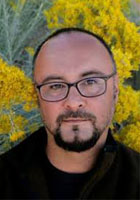James Thomas Stevens
James Thomas Stevens Poems
for Arthur Sze
I.
Somehow precise and unquestionable,
the cut of the Chinese man's hair.
...
I.
The earth and its foregoing, this could be horizon.
Combined, the radicals pressed into one another.
...
As it would for a prow, the basin parts with your foot.
Never a marsh, of heron blue
but the single red feather
from the wing of some black bird, somewhere
...
James Thomas Stevens Biography
Poet James Thomas Stevens, a member of the Akwesasne Mohawk Tribe, was born in Niagara Falls, New York. His Mohawk name, under which he sometimes publishes, is Aronhiótas. As an undergraduate he studied at the School of Visual Arts, Brooklyn College, and eventually at the Institute of American Indian Arts, where he earned an AFA in creative writing. Stevens subsequently earned an MFA from Brown University. Stevens’s free-verse poetry explores the intersection of colonization, memory, and intimacy. In a 2007 Believer Magazine review of A Bridge Dead in the Water, critic Alan Gilbert called Stevens a “lyric poet of love and its accompanying damage—personal and collective.” Stevens’s poetry collections include A Bridge Dead in the Water (2007), Combing the Snakes from His Hair (2002), and Tokinish (1993). He co-authored Mohawk/Samoa: Transmigrations (2006), a collaborative poetry and translation project, with Caroline Sinavaiana. Stevens has received a 2000 Whiting Writers Award, a Witter Bynner Foundation poetry grant, the Kim Ann Arstark Memorial Prize in Poetry, and the City of Santa Fe Writer’s Award. He was also nominated for the Before Columbus Foundation’s American Book Award and for a Pushcart Prize. He was a 2005 finalist for the National Poetry Series. His work has been included in several anthologies, including Eating Fire, Tasting Blood: Breaking the Great Silence of the American Indian Holocaust (2006, edited by MariJo Moore), Poetry and Pedagogy: The Challenge of the Contemporary (2006, edited by Joan Retallack and Juliana Spahr), and Visit Teepee Town: Native Writing after the Detours (1999, edited by Diane Glancy and Mark Nowak). Stevens has taught at Haskell Indian Nations University, the Institute of American Indian Arts, and SUNY Fredonia. He lives in Lamy, New Mexico.)
The Best Poem Of James Thomas Stevens
The Awful Ease of Tides
for Arthur Sze
I.
Somehow precise and unquestionable,
the cut of the Chinese man's hair.
Never before this certainty,
I consider the decision of each strand.
The diameter. The angle.
So black, the way it appears,
crashing against the hard corner of his jaw.
II.
I consider the darkness.
You are appointed court photographer. Consider this picture.
III.
My small face is red behind a bath towel curtain.
I watch a funeral that is taking place next door.
So black, my dog,
hurling himself against a chain link fence.
IV.
The casket is lowered and I am removing rusty pins
from the grease on the window's aluminum track,
along with strands of hair.
V.
This is pressing.
I mark it with an asterisk. Black and large.
VI.
A vague feeling,
pressing itself against a snowfence in my mind.
Like a threat, I view the way you cut your hair
as if it were a history of something small.
